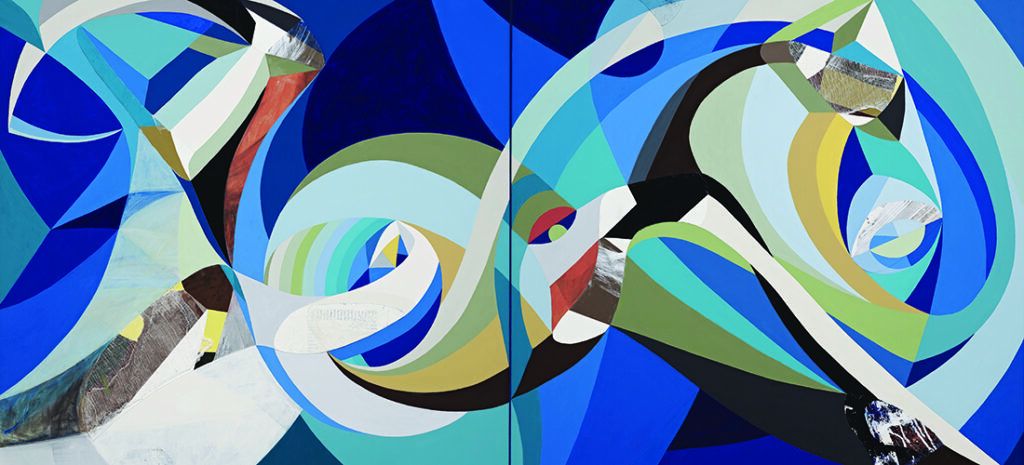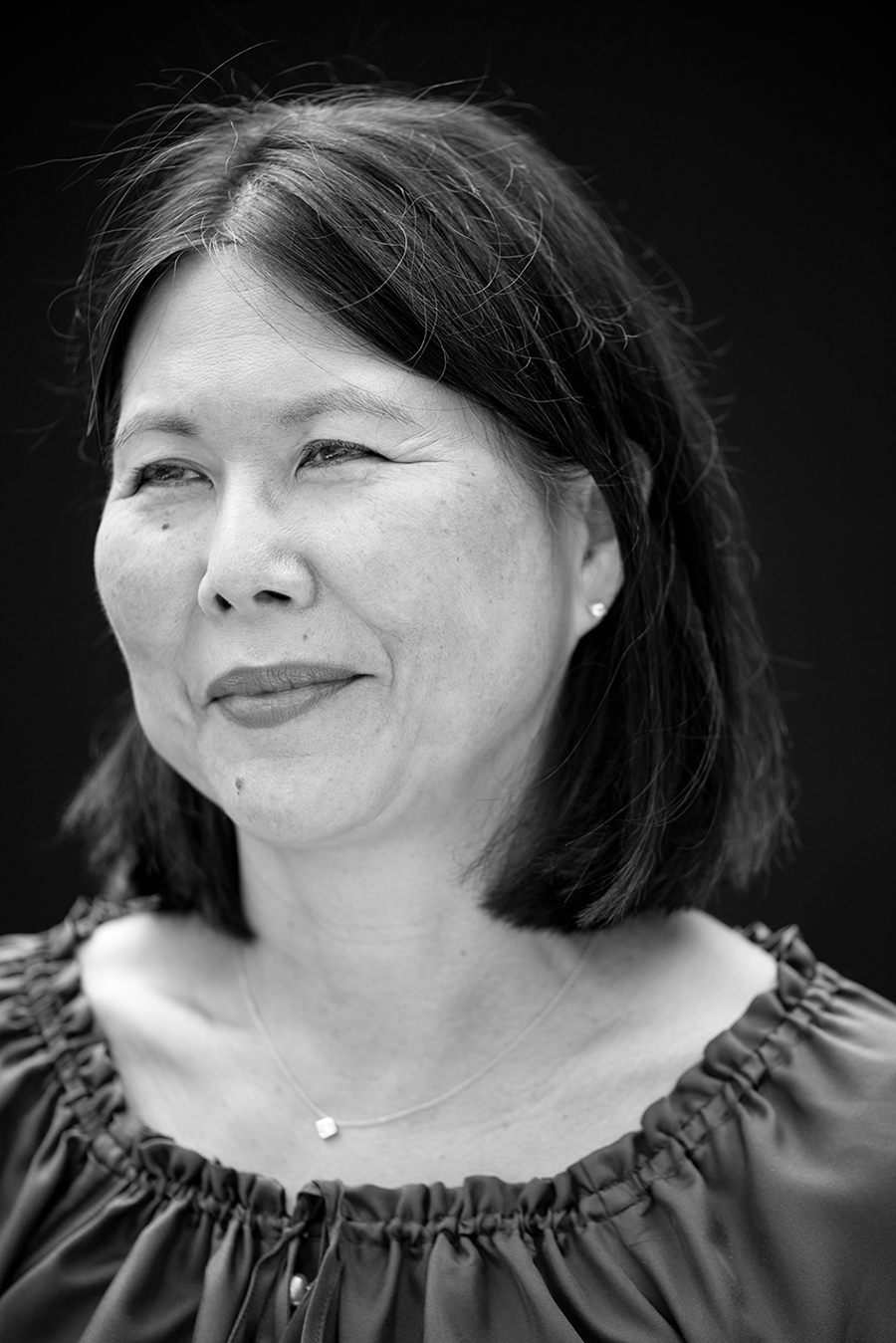Art of the State

Careful Chaos
Chieko Murasugi’s art subverts order and changes perspectives
By Liza Roberts
 Abstract painter Chieko Murasugi has navigated conflicting perspectives all her life. She holds a Ph.D. in visual science and works as an artist; she is the Tokyo-born daughter of Japanese immigrants who was raised in Toronto and lives in America; she is a former impressionist painter who has turned to visual illusion to anchor her geometric art.
Abstract painter Chieko Murasugi has navigated conflicting perspectives all her life. She holds a Ph.D. in visual science and works as an artist; she is the Tokyo-born daughter of Japanese immigrants who was raised in Toronto and lives in America; she is a former impressionist painter who has turned to visual illusion to anchor her geometric art.
“I want to make the elusive, disparate, confusing, multifaceted nature of the world absolutely clear,” says Murasugi. “I want to be clear in my view that the world is unclear.”
Illusions underpin this message; her interest in them is one of the few things that has remained constant in her life. As a scientist, Murasugi studied visual perception because she was fascinated by mysteries like 3D illustrations that seem to flip upside down or right-side up depending on the angle of the viewer, or the ghosts of afterimages, or the way the interpretation of a color changes depending on the colors that sit beside it. Now, as an artist, she uses phenomena like these to tweak a viewer’s perception, to make a picture plane shift before their eyes, to turn it from one thing into another. She populates these paintings with crisp, unambiguous, flat-colored shapes. “I have clarity and I have ambiguity at the same time,” she says. “And that’s really at the crux of my art. It’s the ambiguity, the clarity, the dichotomy.”
Her art creates it, and she’s long lived it. Murasugi grew up in a “very white” Canadian suburb, “very clearly a minority.” As a child, her father, a descendant of 1600s-era samurai, showed her maps of Japan’s former reach across Asia, and told her “Americans took it away.” He told her about how American forces firebombed downtown Tokyo, and how he and her mother barely escaped with their lives.
But these were not facts she’d been taught in school, or heard anywhere else. “I had taken world history, and I had not heard anything about the firebombings of Japan,” she says. “And so everywhere I went, I was presented with diverging, often conflicting, but very disparate narratives. Who am I supposed to believe?” When she was studying for her doctorate at York University in Canada, she recalls, her professors proudly touted the department’s significance in the field. Then she went to Stanford to do postdoctoral work in neurobiology and nobody had heard of her colleagues at York University. “Again, I had to shift my perspective,” she says. Fueling those shifts was an overwhelming curiosity, she says, “always wanting to know why. Why, why, why. Curiosity has been the driving force of my life.”
Years later, when Murasugi left her accomplished academic career and the world of science for art, her viewpoint shifted again. In a deeply rooted way, she was coming home; she had always drawn and painted, and she studied art in college as well as science. Even at the height of her successful scientific career as a professor and research scientist, Murasugi believed that she didn’t truly belong. She thought she wasn’t quantitative, logical or analytical enough, that “there was something that was missing in the way that I was thinking,” she says. With art, the opposite was the case: “I knew I could do it.”
After she moved to North Carolina with her husband several years ago, this innate conviction took her back to school, to the University of North Carolina at Chapel Hill for an MFA. There she met fellow artists she respected and joined with to co-found and co-curate an artist-run Chapel Hill exhibit space called Basement, which has earned a reputation as an incubator for emerging artists and which regularly exhibits their work to the public.
Over the last 18 months, Murasugi has found fresh directions, resulting in a new body of work, called Chance, that explores randomization, color theory, chance and chaos. “My mother was basically dying when I began this series,” she says. “Her impending death, having to process her death, is what inspired it. And I continued it for about a year, because I was just bereft.” Murasugi’s mother survived World War II “by chance” and always thought of her life as defined by that good fortune; this fueled Murasugi’s experimentation with art made, in part, “by chance.”
Using an algorithm available on the website random.org to arrange her own colors, shapes and patterns into random arrangements and compositions, Murasugi created a series of colorful, geometric works. In late summer 2022, she posted these works on the Instagram feed of Asheville’s Black Mountain College Museum + Arts Center, part of her digital residency with the museum. She also exhibited them at Craven Allen, her Durham gallery.
More recently, Murasugi has returned to the illusion-anchored canvases she began a few years ago — what she now refers to as her “old way of painting.”
It has been “a huge struggle,” she says, because “the end point is unknown.” Unlike the work made with the guidance of the randomizing program, “the trajectory is not straightforward” with these newer, intuitive paintings. “It’s forward and backwards, left and right. I’ve always worked this way, before I went to the Chance series, and I’d almost forgotten how difficult painting is. Both fun, and excruciatingly difficult.” Some of the pieces currently underway will find their way to CAM Raleigh for a show called Neo-Psychedelia that opens Nov. 10. She will also have a piece featured and sold at ArtSpace’s ArtBash, a fundraising gala, on Nov. 18, also in Raleigh.
Murasugi’s work has also been exhibited in museums in San Francisco, New York and across the South, and is in the collections of the City of Raleigh and Duke University. Its abstraction welcomes any interpretation at all; its subtle illusory elements gently subvert them. “People have said to me over the years: Your work is so beautiful. And I think, well, I hope it doesn’t stop there,” she says. “As long as they see that there were two ways of looking at it.” OH
This is an excerpt from Art of the State: Celebrating the Art of North Carolina, published by UNC Press.
